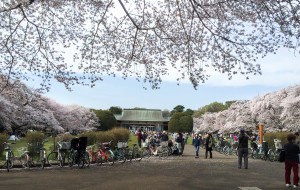 Koganei Park
Koganei Park
Koganei Park (小金井公園) is an 80-hectares wide open park located in the western suburbs of Tokyo with entrances in Koganei City, Kodaira City, Nishitokyo City, and Musashino City. It is about 40-60 minutes away from the central Tokyo. It has about 1,700 cherry trees planted around it and is considered as one of the best Cherry Blossom Spots in Japan.
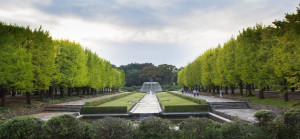 Showa Kinen Park
Showa Kinen Park
This park Officially known as Showa Commemorative National Government Park (国営昭和記念公園) is located in Tachikawa, which is only a little over 30 minutes by train from Shinjuku station. The park has about 163 hectares land area and includes sport fields, barbecue pits, a boating pond, pools, and different magnificent gardens that blooms at various time throughout the year.
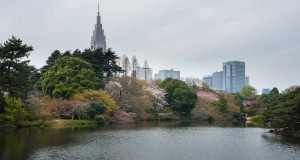 Shinjuku Gyoen
Shinjuku Gyoen
ShinjShinjuku Gyoen National Garden (新宿御苑) is one of the largest park in Tokyo with a land area of 58.7 hectares and circumference of 3.5 kilometers. It is located just a short walk from either Shinjuku or Sendagaya stations. It provides a relaxing and tranquil atmosphere which makes it a popular destination in the city.
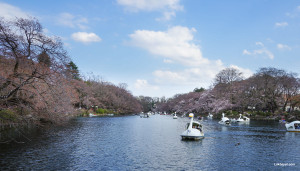 Inokashira Park
Inokashira Park
Inokashira Park (井の頭恩賜公園) is a 43-hectares park located on the western side of Tokyo and sits on both Mitaka and Musashino cities. It is easily accessible via the lively Kichijoji neighborhood. It is very popular during the Cherry Blossom season as the branches of about 250 cherry trees lined-up around the banks of a large pond spread and reflect over the water and creates a stunning view.
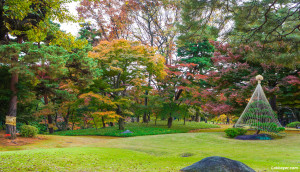 Tonogayato Garden
Tonogayato Garden
Tonogayato Garden (殿ヶ谷戸庭園) is a 21,124 m2 traditional Japanese garden in Kokubunji, Tokyo. The garden was constructed from 1913 to 1915 as part of a villa for Teijo Eguchi, the Vice-President of the Manchurian Railway. It was purchased by the founder of Mitsubishi, Iwasaki Yataro, in 1929. It was then purchased by the City of Tokyo in 1974 and opened it to the public in 1979.
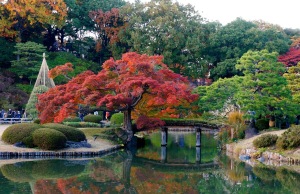 Rikugien Garden
Rikugien Garden
Rikugien Garden (六義園) in Bunkyō-ku is was built in the 1700. It is a typical Edo Period strolling garden which consists of a small pond, river, trees, and hills surrounded by forested areas and it is famed as one of the most beautiful traditional Japanese garden in Tokyo.
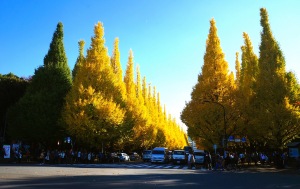 Meiji-jingu Gaien Park’s Ginkgo Avenue
Meiji-jingu Gaien Park’s Ginkgo Avenue
The Icho Namiki (銀杏並木) or Ginkgo Avenue located in Meiji-jingu Gaien Park, just a short walk from Aoyama-Itchome Station, is one of the most popular autumn viewing spot in Tokyo. Around 300 meters long boulevard turns into a golden corridor which seems to transport visitors to a different world.
 Koishikawa Korakuen Gardens
Koishikawa Korakuen Gardens
Koishikawa Kōrakuen Garden (小石川後楽園) is one of the surviving gardens from the Edo period and one of Tokyo’s oldest and best preserved Japanese garden. The garden is attractive throughout the year specially during the cherry blossom and autumn seasons. The garden features beautiful weeping cherry trees around the garden’s entrance gate and several Someiyoshino Sakura near the pond.Numerous maple and ginkgo trees are planted along walking trails.
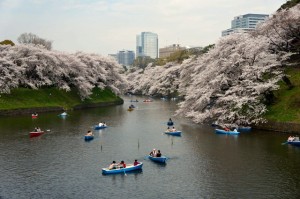 Chidorigafuchi
Chidorigafuchi
Chidorigafuchi (千鳥ヶ淵) is a moat in the northwest of the Imperial Palace with over 200 hundred cherry trees planted along the 700 meter pedestrian path. It is one of the best spots to view cherry blossoms as it offers a breathtaking view of the sakura branches reflecting in the water. Rental boats are also available for visitors who wish to admire the beautiful blossoms from the water.
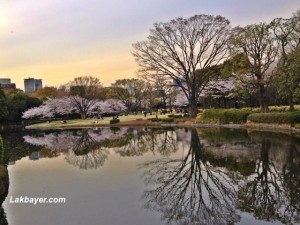 Kitanomaru National Garden
Kitanomaru National Garden
Kitanomaru Park (北の丸公園) is a part of the Imperial Palace Outer Gardens and was formerly the northern fortress of Edo castle. It was opened to public in 1969. It has several cherry trees and a wide lawn which makes it an ideal hanami place.